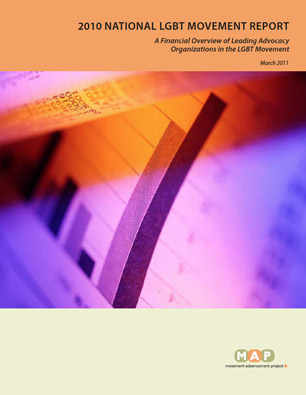The Bottom Line
The 2010 National LGBT Movement Report examines revenue and expenses, fundraising and fundraising efficiency, and other indicators of financial health for lesbian, gay, bisexual and transgender (LGBT) social justice advocacy organizations. While movement organizations overall experienced significant declines in revenue in 2009 compared with 2008, their financial health remains strong due to reduced expenses and efficient fundraising.
- 2010 National LGBT Movement ReportDownload
Abstract
The 2010 National LGBT Movement Report provides a comprehensive snapshot of the financial health of LGBT social justice advocacy organizations. The 39 organizations examined for the 2010 report collectively represent 69% of the budgets of all LGBT social justice advocacy organizations. Among the key findings:
Revenue and Expenses. Organizations are experiencing significant declines in revenue (down 20% from 2008 to 2009), a sign of the combined effects of the economic downturn and decreased giving in an off-election year (2009). Organizations are adjusting to revenue declines by cutting expenses; 2010 budget estimates are down 18% from 2009 to 2010.
Fundraising and Fundraising Efficiency. Organizations are faring relatively well at retaining smaller donors, but are losing larger donors who give $1,000 or more per year. Fewer donors are attending fundraising events and organizations show less income from these events as a result. However, despite recent fundraising challenges, LGBT social justice advocacy organizations continue to be quite efficient in their fundraising, with an average of 79% of expenses being spent on programs and services, 9% on management and general expenses, and only 12% on fundraising.
Other Indicators of Financial Health. Other indicators remain strong. Reduction of expense budgets has helped organizations maintain good average working capital, liquidity ratios, and cash and cash equivalents.
The report also looks at the staff and boards of LGBT social justice advocacy organizations, assessing staff diversity.
Participating Organizations:
ACLU LGBT & AIDS Project
CenterLink
COLAGE
Council for Global Equality
Empire State Pride Agenda
Equality California
Equality Federation
Equality Forum
Family Equality Council
Freedom to Marry
Gay & Lesbian Advocates & Defenders (GLAD)
Gay & Lesbian Alliance Against Defamation (GLAAD)
Gay & Lesbian Victory Fund and Leadership Institute
Gay, Lesbian and Straight Education Network (GLSEN)
Gay-Straight Alliance Network
GroundSpark
Human Rights Campaign (HRC)
Immigration Equality & Immigration Equality Action Fund
In the Life Media
Lambda Legal
Log Cabin Republicans & Liberty Education Forum
MassEquality
National Black Justice Coalition
National Center for Lesbian Rights
National Center for Transgender Equality
National Gay and Lesbian Task Force
National Youth Advocacy Coalition
New York City Gay and Lesbian Anti-Violence Project
Out & Equal Workplace Advocates
The Palm Center
Parents, Families and Friends of Lesbians and Gays (PFLAG)
Point Foundation
Servicemembers Legal Defense Network
Services & Advocacy for GLBT Elders (SAGE)
Soulforce
Sylvia Rivera Law Project
Transgender Law Center
The Trevor Project
(One organization wished to remain anonymous)



